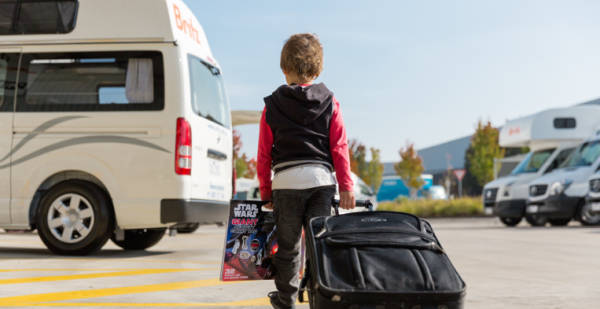


Join thousands of fellow campervan travellers
Sign up for our Britz newsletter to receive inspirational travel content and awesome deals, and we'll send you a copy of our Ultimate RV guide!
Thanks
Please confirm subscription in your email.
Victoria Must Do's
With famed coastal drives, sensational food and wine, and an abundance of epic scenery, Victoria is an incredible spot for a campervan road trip. With enough activities both inner city and further afield to keep you entertained for days, check out our favourite things to do in Victoria below.
Victoria Campervan Road Trips
Victoria is all about diversity and beauty, with various spectacular routes to explore, it is the perfect spot for a campervan trip. Take a trip along the iconic Great Ocean Road and explore the south-eastern coast of Australia to get familiar with the stunning coastline, towering cliffs and historical landmarks. Take a Gippsland Getaway and experience the solitude this destination has to offer by exploring its pristine beaches and rolling hills of farmland. For a more relaxed trip, head to the High Country and indulge in local delights, fine dining and explore the many cellar doors around this destination.
Victoria Travel Tips & Inspiration
Need some more travel tips and inspiration before heading on your campervan road trip through Victoria? Check out more of our travel guides below.
Campervan Deals For Victoria
Explore the sights of Victoria from the Great Ocean Road, Gippsland or High Country with these great campervan deals. See how much you could save on your next trip.

Our Melbourne Campervan Branch
Britz Melbourne are the experts when it comes to campervan hire in Victoria. Our Melbourne branch is located near the airport, making it a great place to start a campervan trip on one of these classic Victoria itineraries or to explore one of the many iconic destinations in this beautiful region.
Helpful Information
Visitor Information
Climate:
Despite its small size, the Victorian climate varies across the state. The north has much drier and warmer weather than the south. Australia's seasons are the reverse of those in the northern hemisphere. The climate can be characterised as warm to hot in summer (December to February), mild in autumn (March to May), cold and damp in winter (June to August), and cool in spring (September to November).
What To Pack:
Casual clothing for travelling & activities and smart casual for evening dining is recommended. Make sure you bring comfortable walking shoes, sunscreen, sunglasses, hat, insect repellent, towel, swimwear, all-weather coat/jacket and a warm sweater/jacket.
Wine and Food:
Victoria boasts over 350 wineries in 22 distinct wine regions. Enjoy tastings at the cellar door and dine on local produce at winery restaurants. From the cool-climate varieties of the Yarra Valley to the big reds of Rutherglen, you won't have to travel far to taste fantastic wine in Victoria.
Melbourne's Surrounds are unique – five winegrowing regions within 90 minutes of the city. And where there's good wine there's always great food, markets and festivals. Head west to mountains, Goldfields and four distinctive wine regions. Follow the Great Ocean Road and the Great Grape Road tasting spectacular wines along the way. With its Mediterranean climate tempered by the Murray River, north-west Victoria is home to vast orchards, citrus and olive groves, grain fields and of course, vineyards. Stretching from the bountiful Goulburn Valley, west to the opulent city of Bendigo, east to the magnificent High Country, and north to Echuca on the Murray. Five individual regions – Rutherglen, Beechworth, Glenrowan, King Valley and Alpine Valleys – producing a diverse range of wines from old-style fortified to the newer Italian varietals. Head east to Gippsland and three separate sub-regions with their own microclimates and wine styles. Discover over 100 individual vineyards and about 30 small, family-owned wineries.
Things To Do
Wildlife Encounters:
Victoria’s fascinating native wildlife includes kangaroos, koalas, wombats, platypus, echidnas and lovable Little Penguins, which parade nightly along the beach. At Ballarat Wildlife Park, you can experience close contact with koalas, wombats, kangaroos and even crocodiles. Ballarat Wildlife and Reptile Park houses a rich collection of Australian wildlife in 16 hectares of natural bushland. The Healesville Sanctuary is one of Australia’s premier wildlife parks with more than 200 species of native birds, mammals and reptiles, beautifully displayed in their natural habitats. At the Melbourne Zoo you can view more than 350 animals in brilliant botanical settings. Wander through an African and Asian Rainforest displaying gorillas, pygmy hippopotamuses, mandrills, tigers and otters. There is also an extensive collection of Australian animals to see including koalas, kangaroos, wombats, platypus, penguins and seals. Other highlights include the Butterfly House and an authentic Japanese Garden. At Werribee Open Range Zoo head out on a guided safari tour through wild grassy plains and sweeping river terraces rich with rhino, giraffe, antelope, zebra and hippo. Walk a fascinating trail to discover cheetah and monkeys at play then come face to face with Lions on the Edge.
National Parks:
Experience the beauty and diversity of natural Victoria. Walk through tall trees, through manicured gardens or along wild coastlines, head out to the desert, take in the view from the top of a mountain, or observe Australian birds and animals in the wild. The Twelve Apostles are spectacular rock stacks that rise up to 70 metres from the Southern Ocean. The 20 million year old formations are seen best from lookouts between Apollo Bay and Port Campbell. Croajingolong National Park extends for 100 kilometres along the wilderness coast of Victoria's East Gippsland. It protects remote beaches, tall forests, heathland, rainforest, estuaries and granite peaks. Grampians National Park is renowned for rugged mountain ranges and stunning wildflower displays, and the park is a popular destination . The 167,000-hectare park is home to abundant bird life and almost a third of Victoria's plant species.
Coastal Must Do's:
Victoria has almost 2,000 kilometres of coastline, which stretches from the South Australian border to the New South Wales border in the north-east corner of Victoria and fronts the Southern Ocean, Bass Strait and the Tasman Sea. The Victorian coastline is always changing, due to weather, wind, waves, and tides. The landscape ranges from sand dunes, wetlands and heathland, to forests and woodland, sheer cliffs, rocky shores and sandy beaches. National, state and coastal parks protect much of the coastline, with more than 20 marine parks and sanctuaries protecting the waters up to 5.5 kilometres offshore. The Great Ocean Road has some of Australias best beaches. Discover kilometres of clean, golden sand and crashing waves all along the coast. One of Gippsland's highlights, the Ninety Mile Beach is one of the longest and most beautiful stretches of sand in the world offering a wealth of beach activities. Mornington Peninsula spoils you for choice with calm sandy beaches that extend from Frankston near Melbourne along the length of the Peninsula.

